Repairs Gallery...
Guitar Restorations, Setups and Repairs
*Please scroll using the arrows…
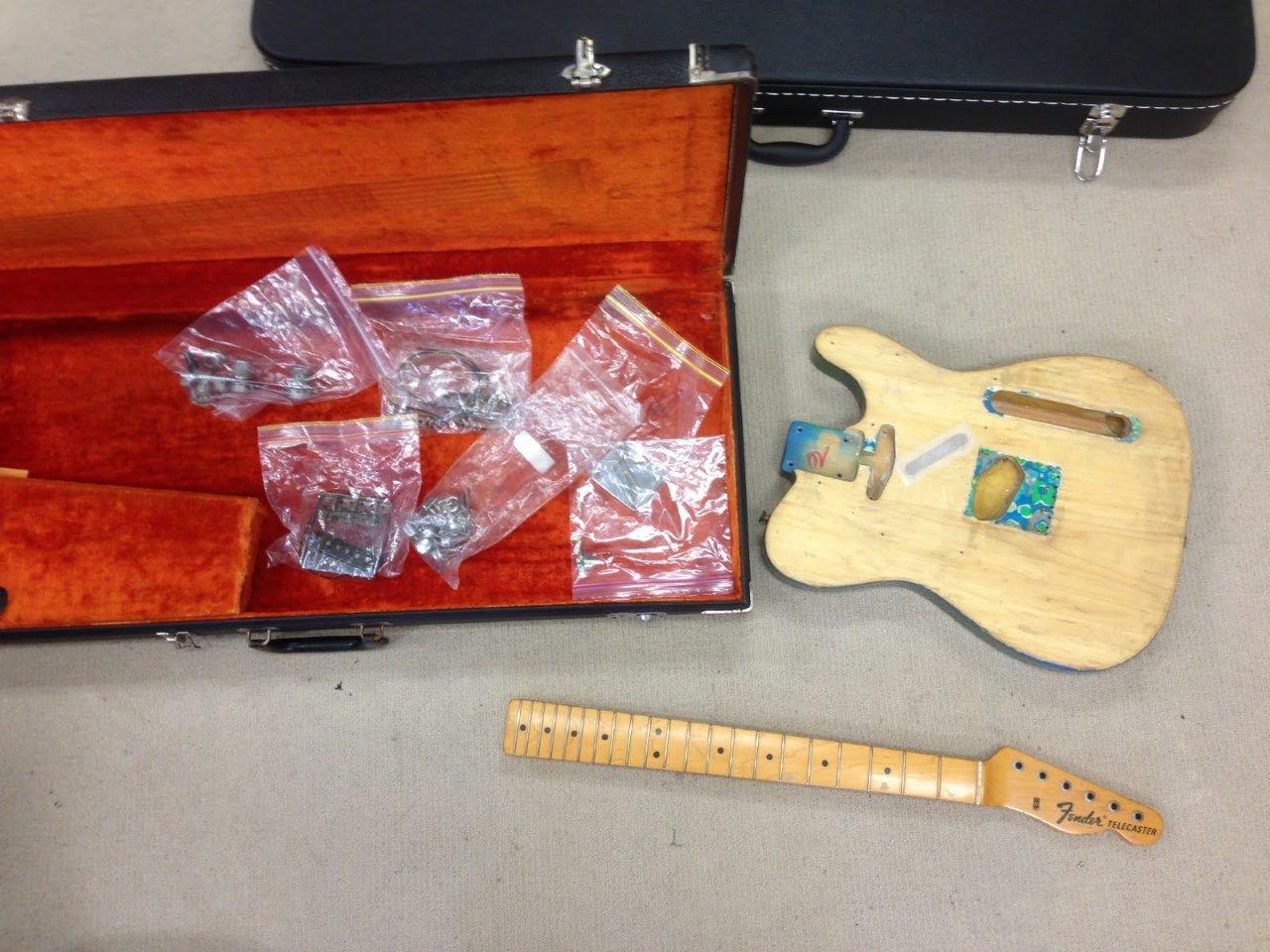
1968 Blue Flowers Tele Restoration.
A 1968 Blue Flowers telecaster as I received it with the specific instructions to “make it like a new guitar”!
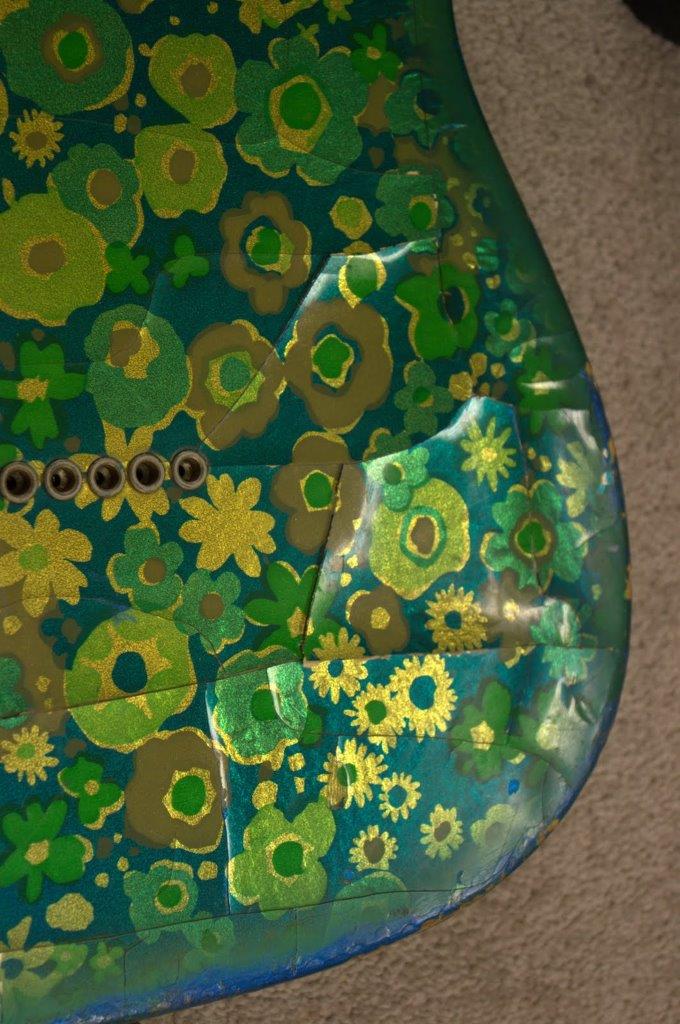
As is often the case with the Blue Flowers and Paisley Tele’s of 68 & 69 the wallpaper print has lifted and cracked to the point of being unsalvageable.
Along with the fact that the job arrived with the top already stripped the only thing to do was continue with the process of removing the lifting paper and poly finish from the back.
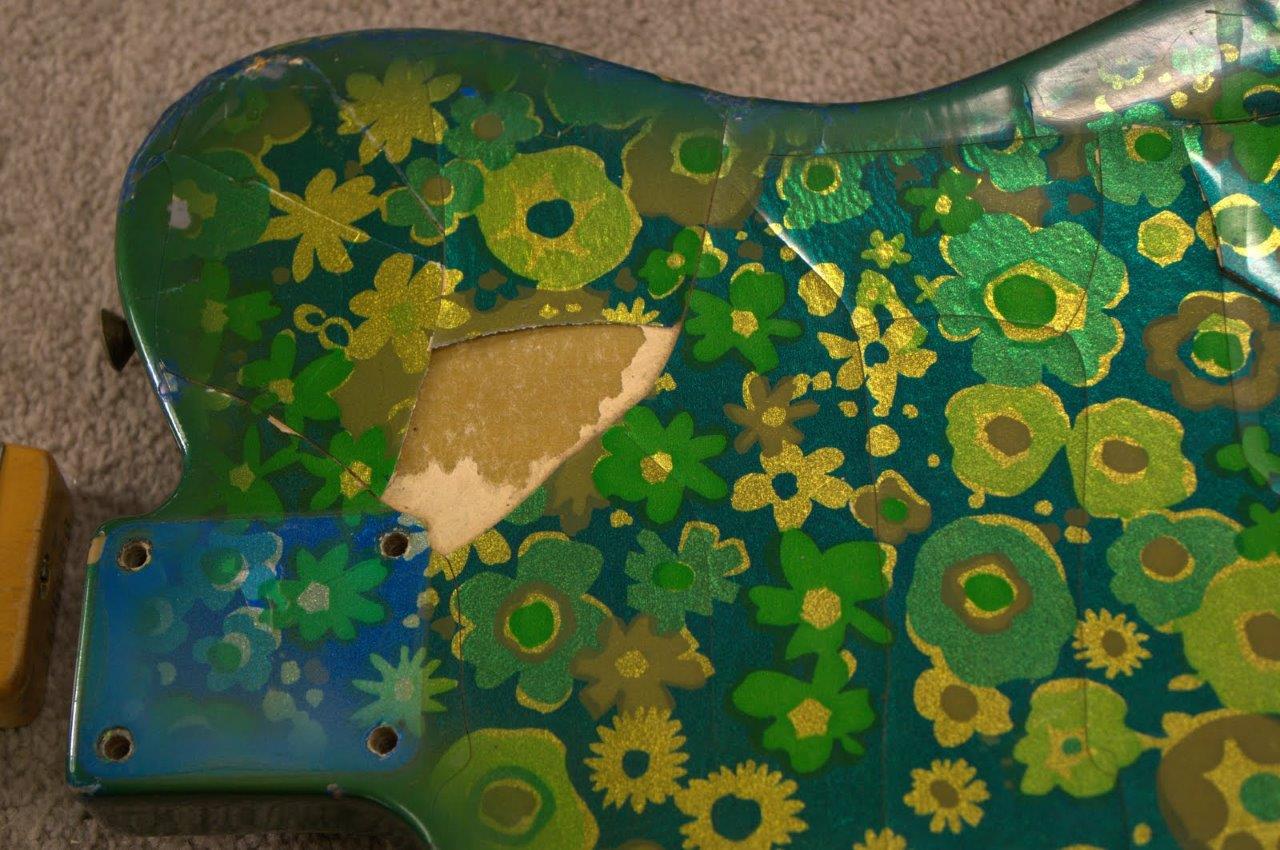
As can be seen under the neck plate area the colour is unfaded “Lake Placid blue”. This was likewise burst around the edges.
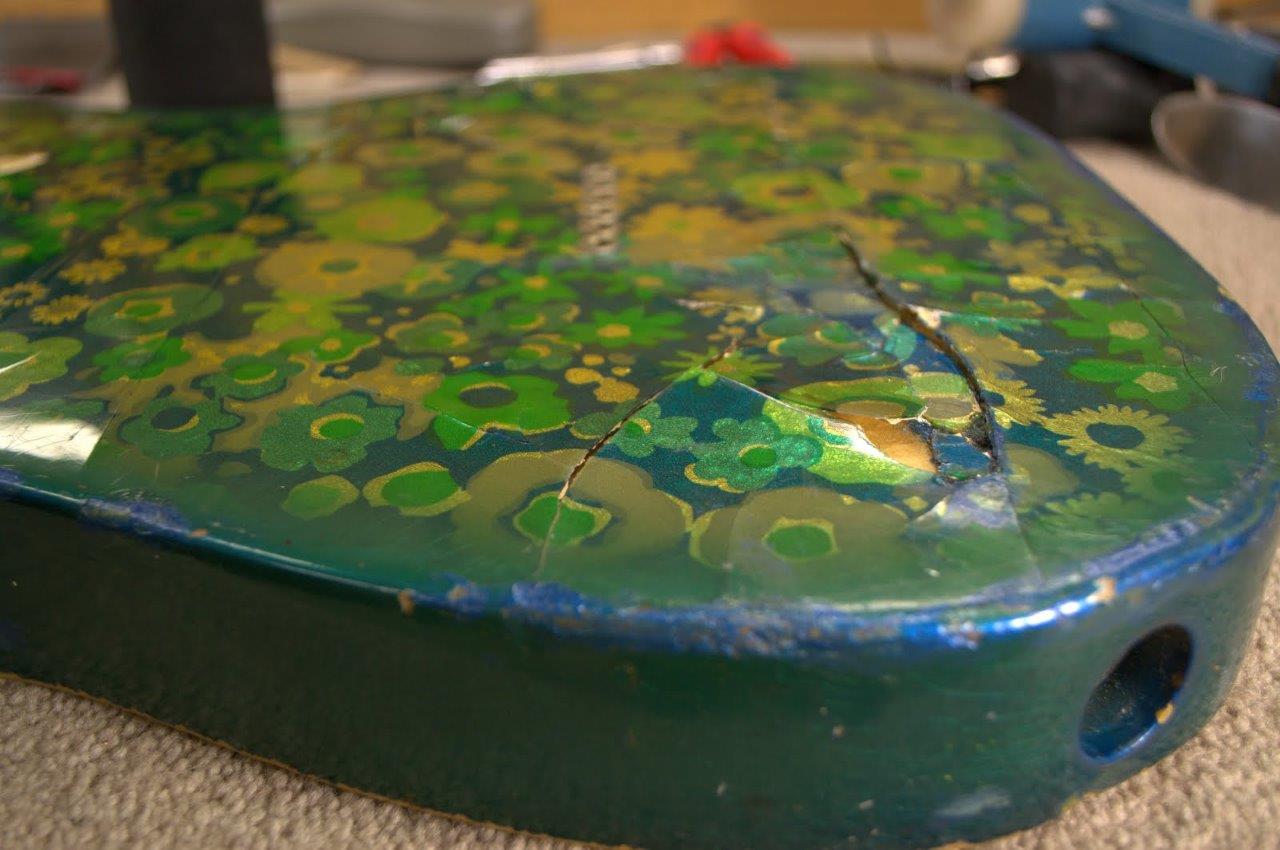
The plan was to refinish the body in its original colour to retain its sense of “provenance”. Likewise to retain all the segments of the wallpaper after it was removed.
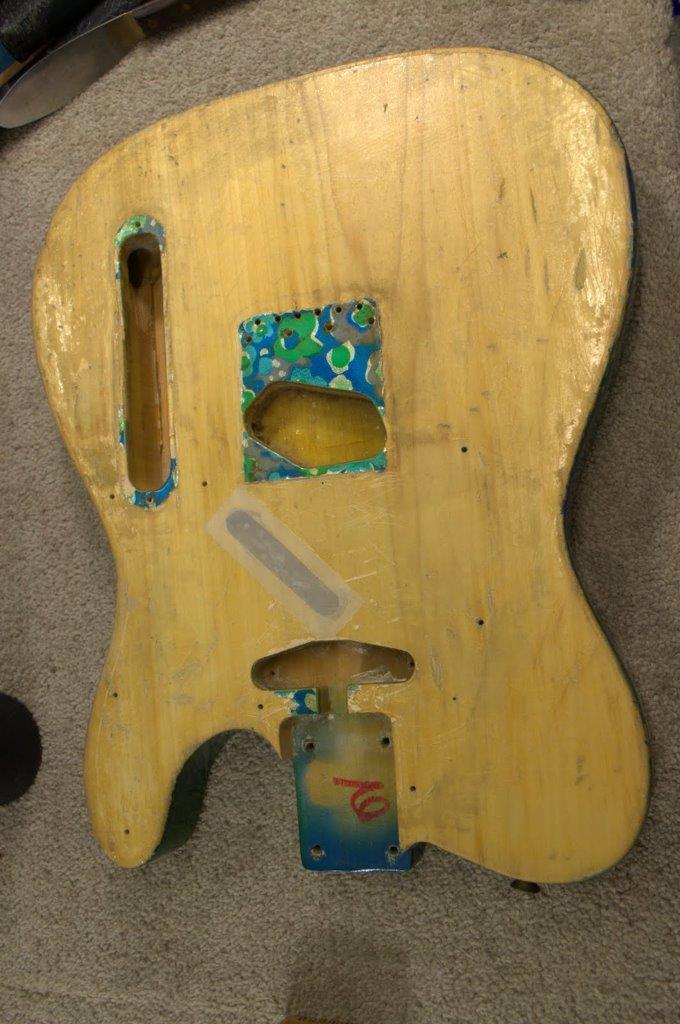
What can’t be fully appreciated by the next 2 shots is the enormous amount of work to repair the myriad of dents, marks, gouges, scrapes etc, etc. Remembering that the owner’s specific instruction was “Like new”!
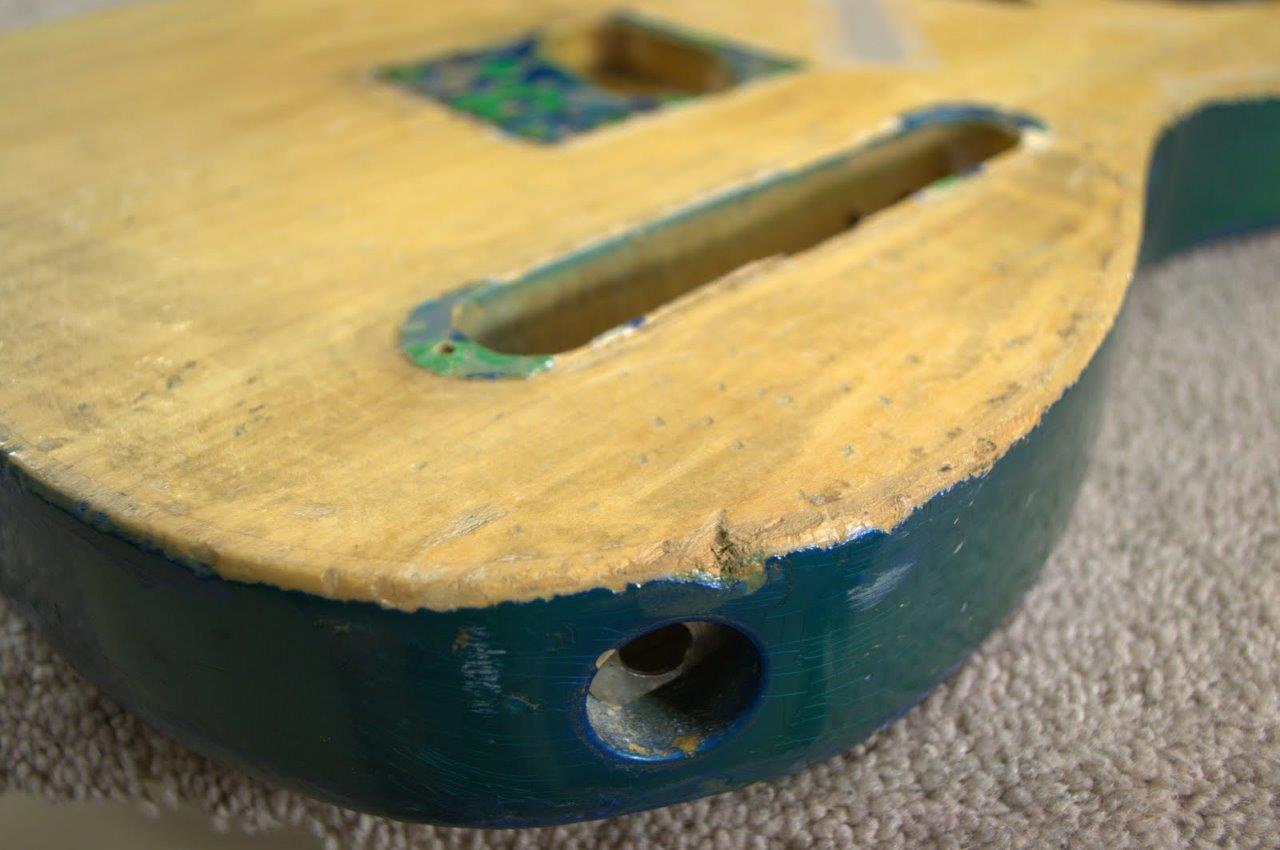
(see prior description)
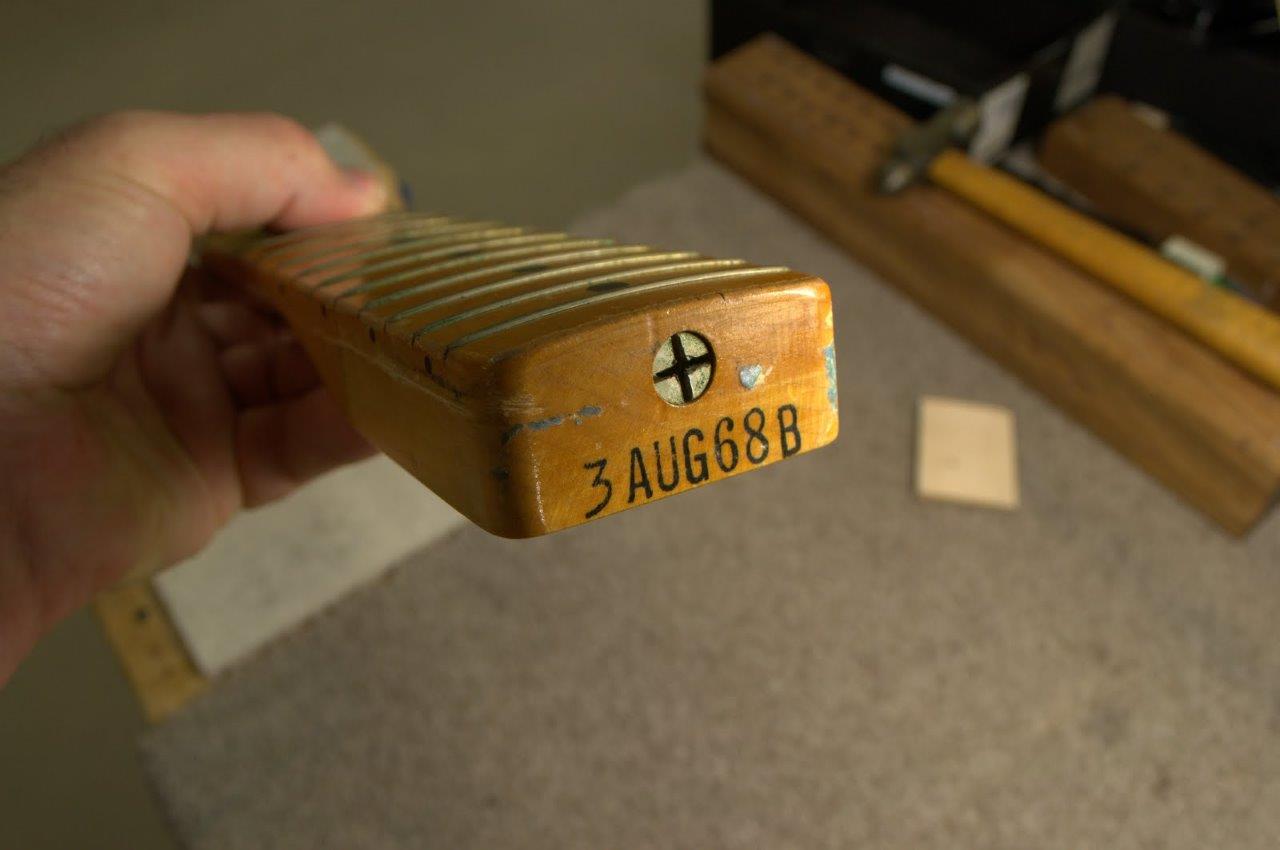
Just to point out the obvious!
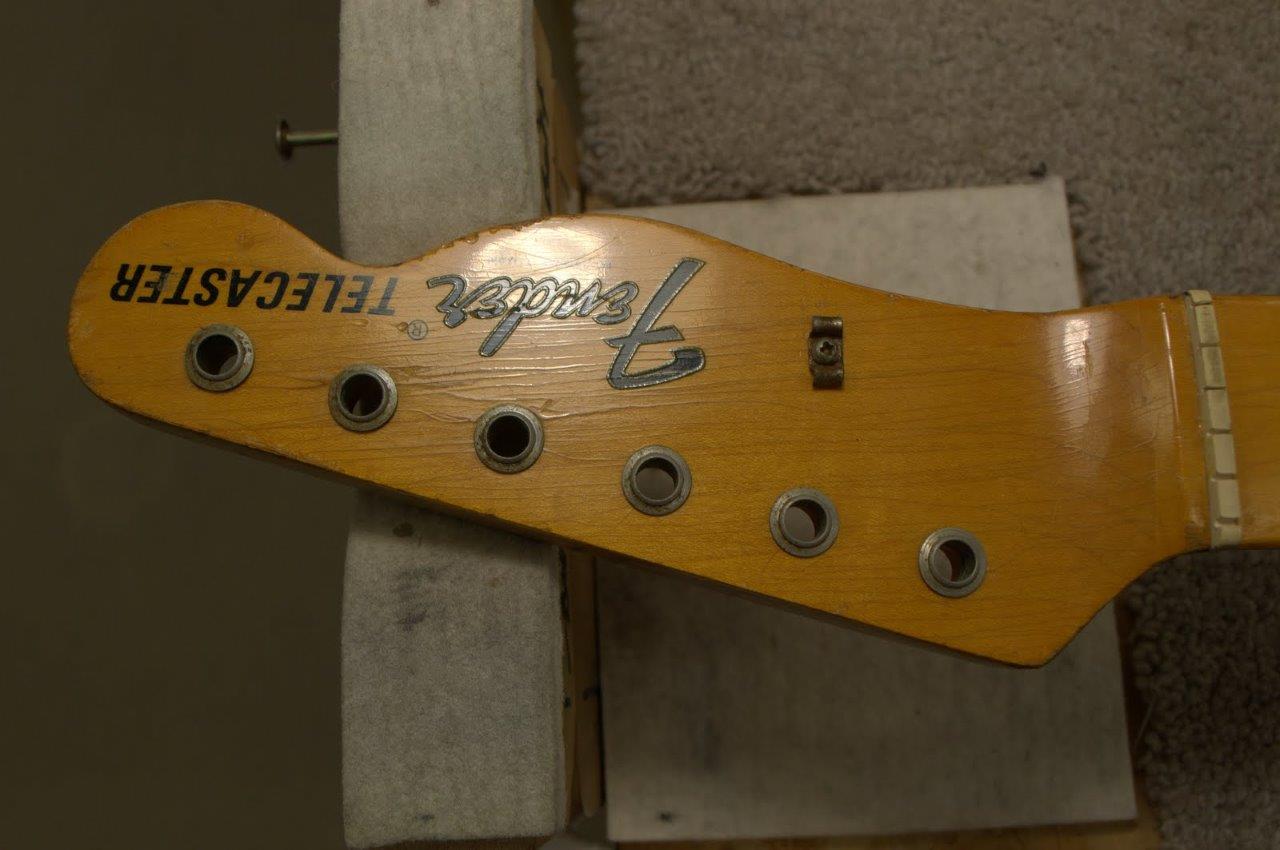
…And again…

It’s interesting what happens to Red alder when its coated with what was in all likelihood an acid cure polyester. The green was perhaps original and the reason why it did not make the grade for a sunburst, but the rest has quite a “bleached look” about it. Having already done a second 68 Tele earlier for the same owner the colour of the wood was the same. Not at all like the usual colour of Red alder but rather a washed out bleached colour. Both were originally acid cure Polyester.
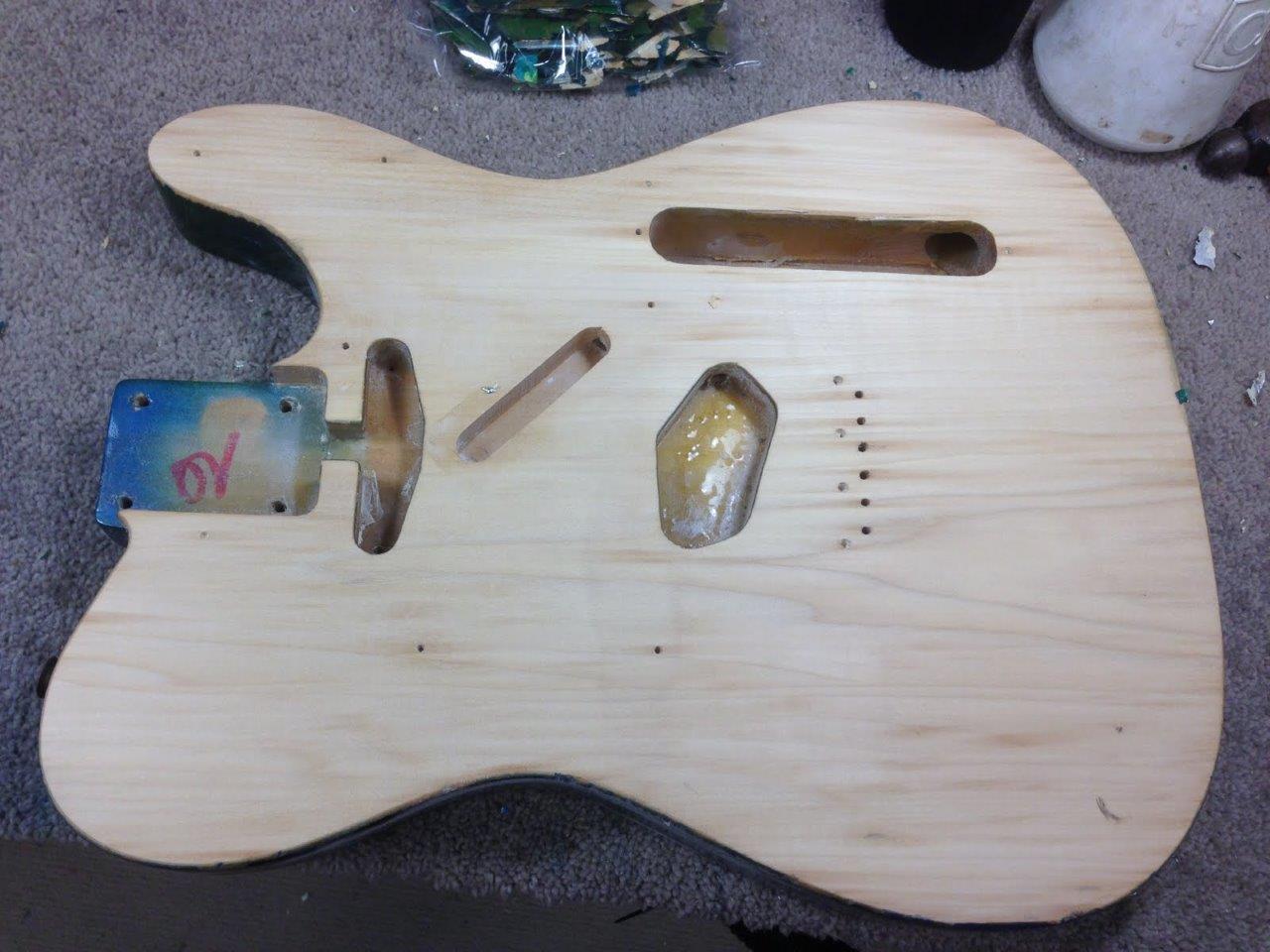
(See prior)
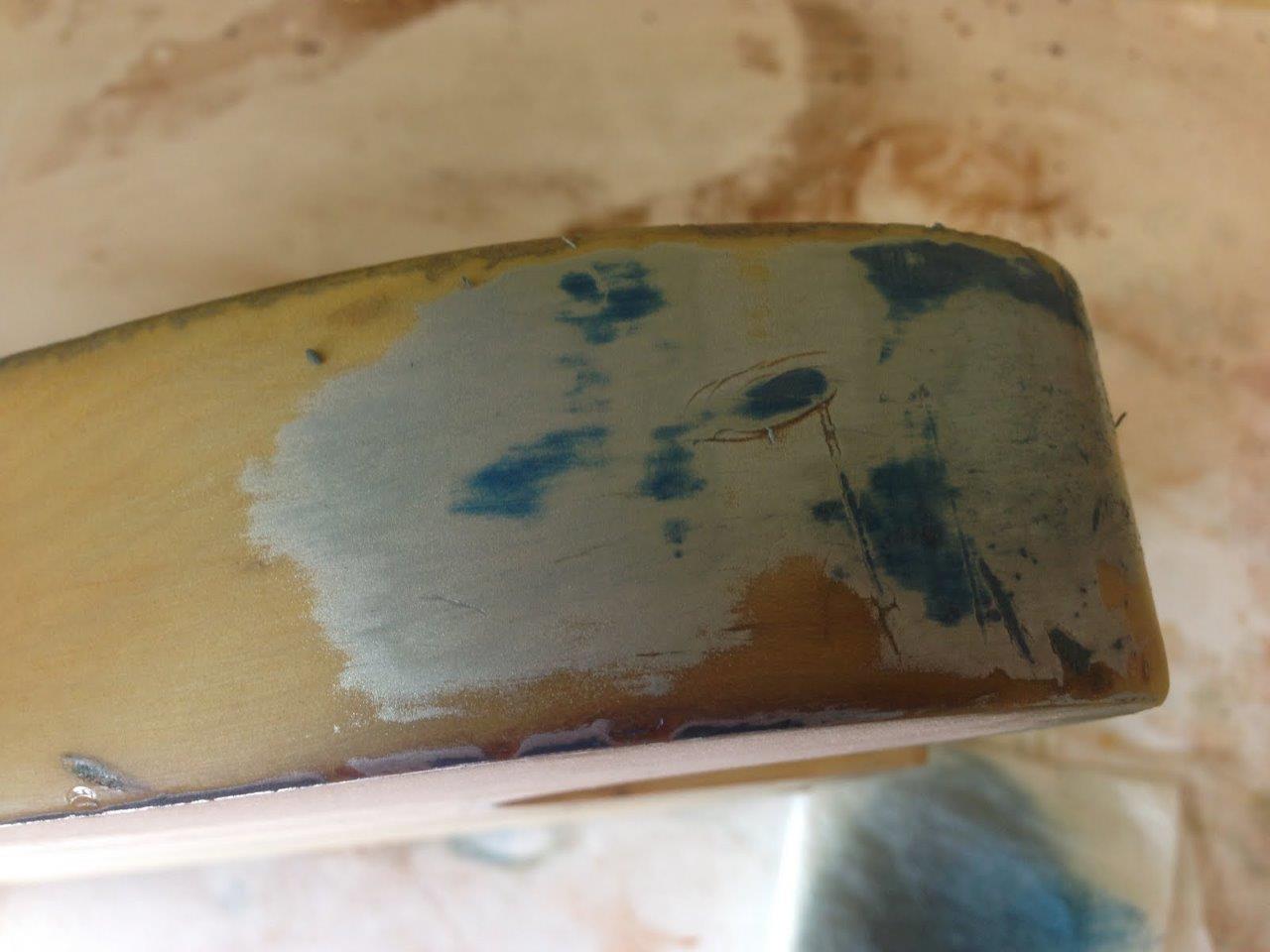
More dents, more dents, more dents & the silver base coat for the LPB burst edges.
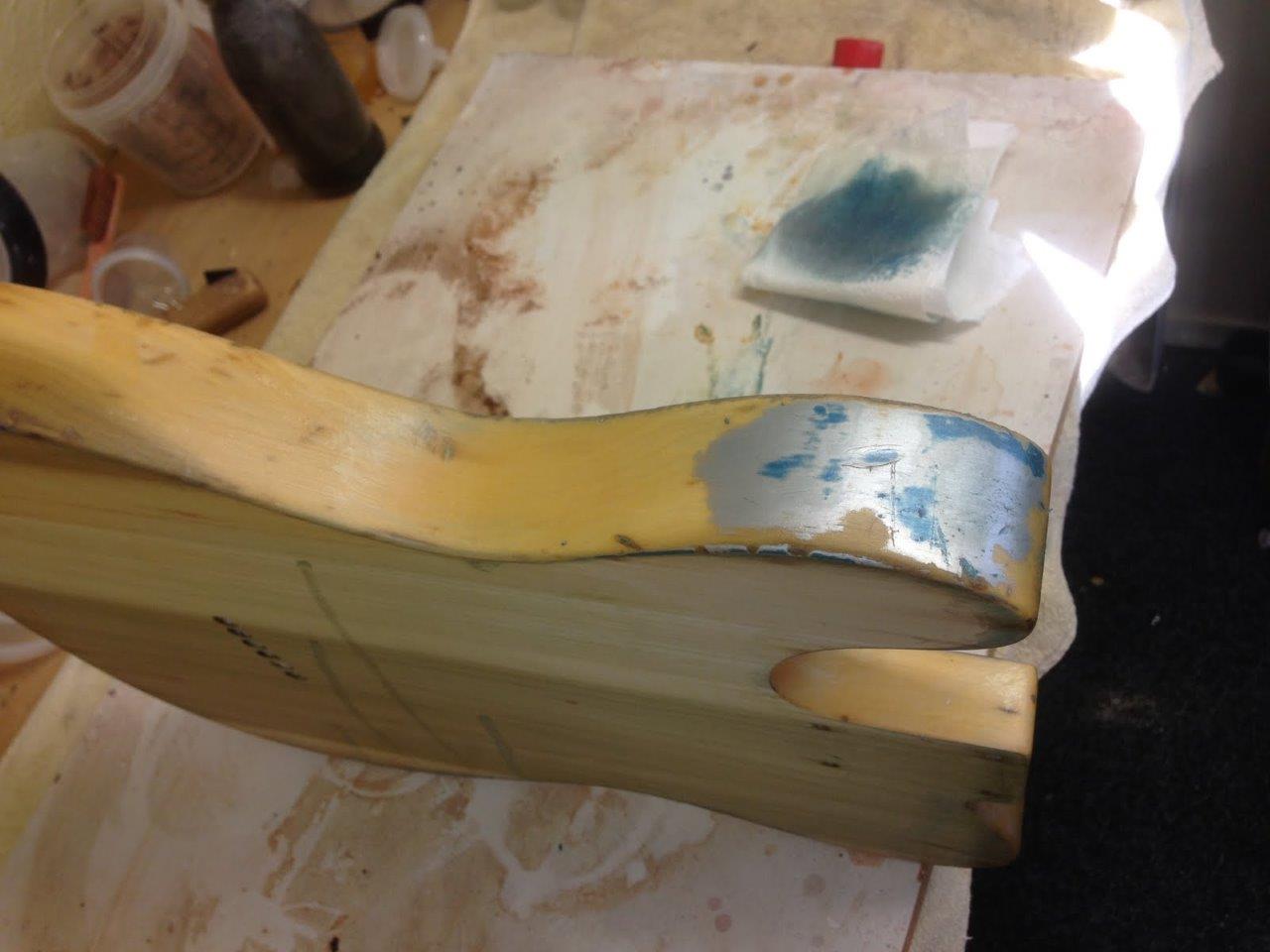
(see prior)

Ready now for the time consuming part called dent repair…..

Here we have the neck already re-fretted, fully stripped & ready to be refinished
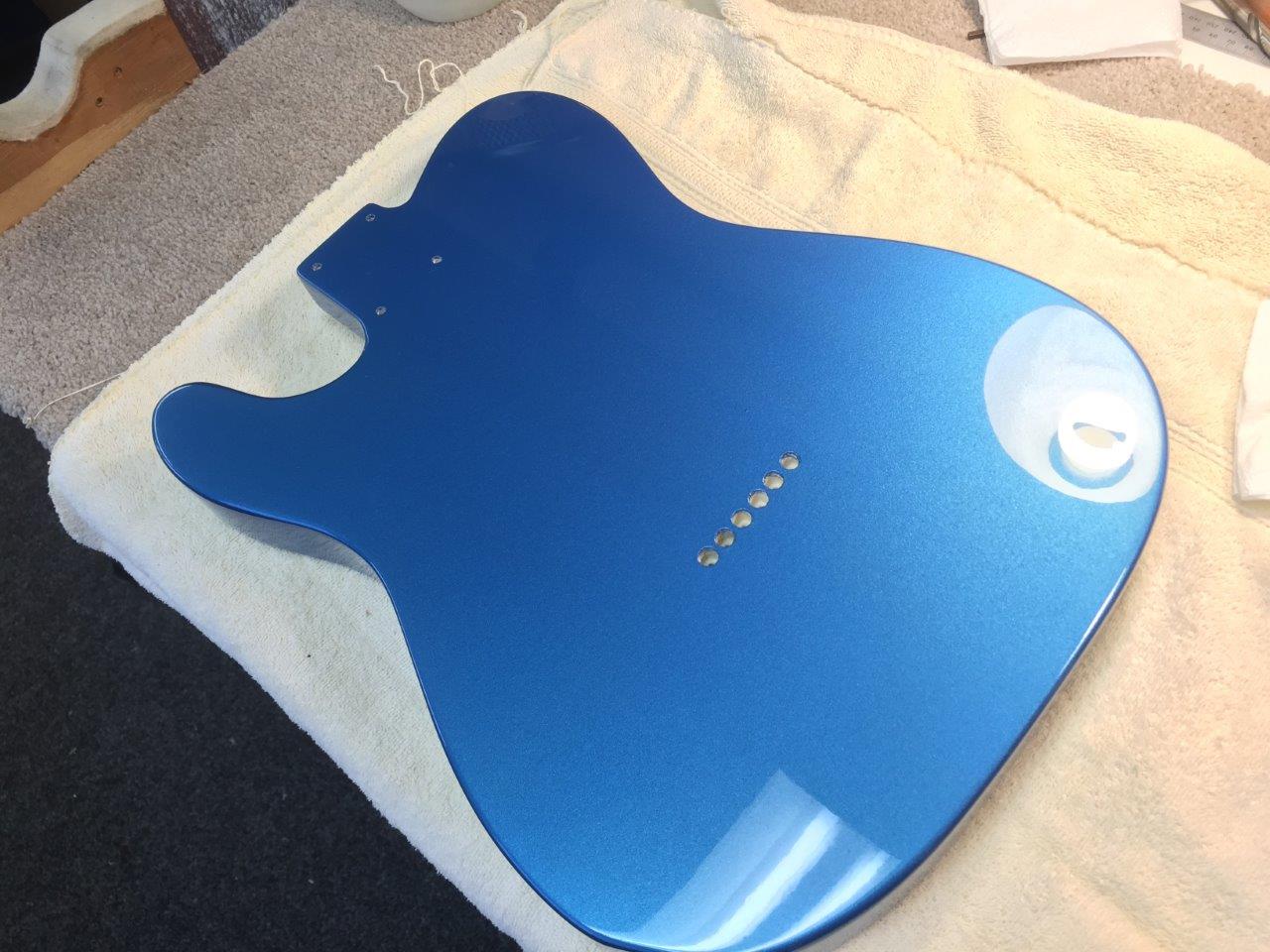
Having completed all the paintwork we are now on the home stretch. A new “lightly aged” Lake Placid Blue finish with the original brand (Lucite) that Fender used back in the day.
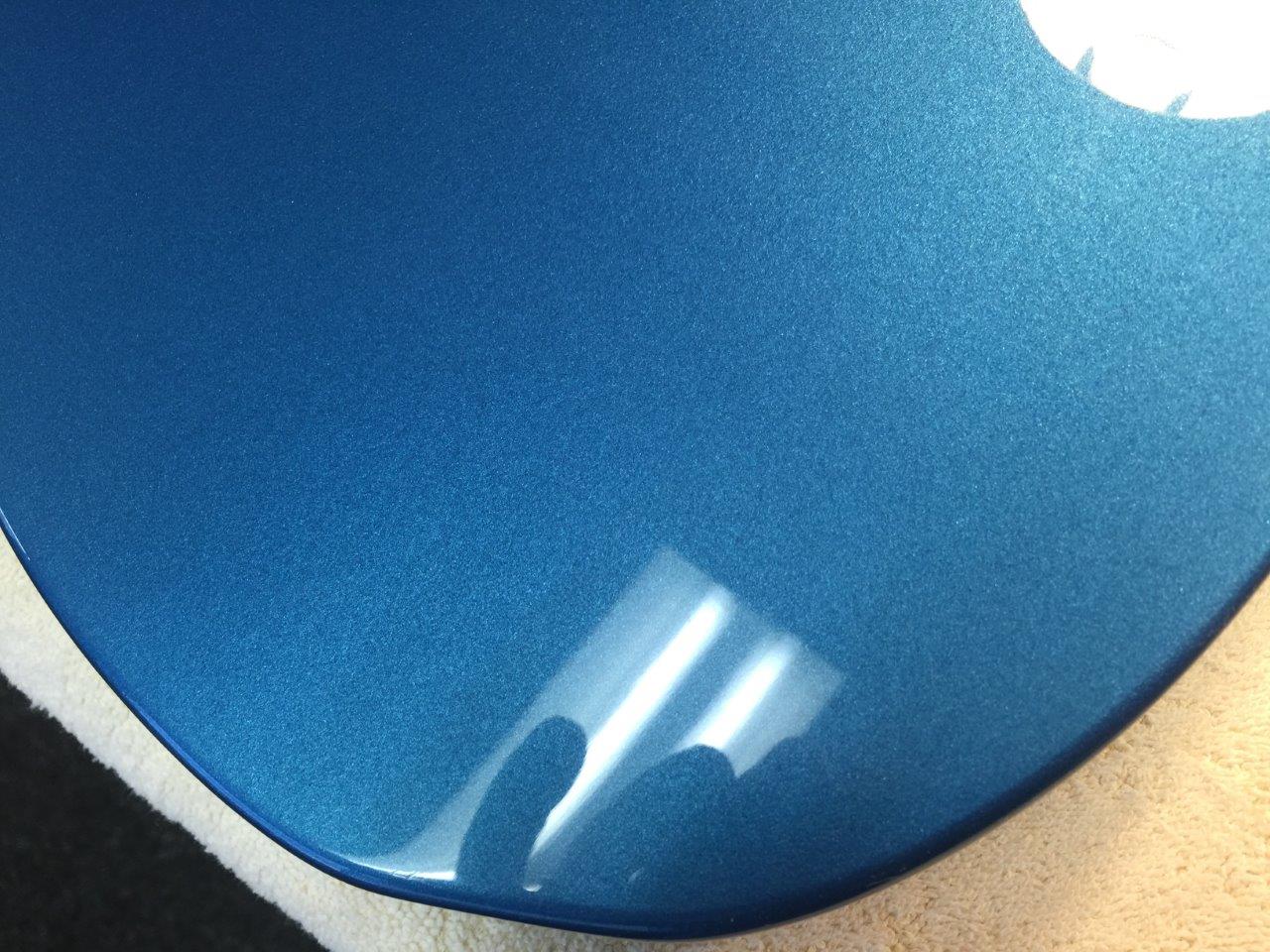
(see prior)
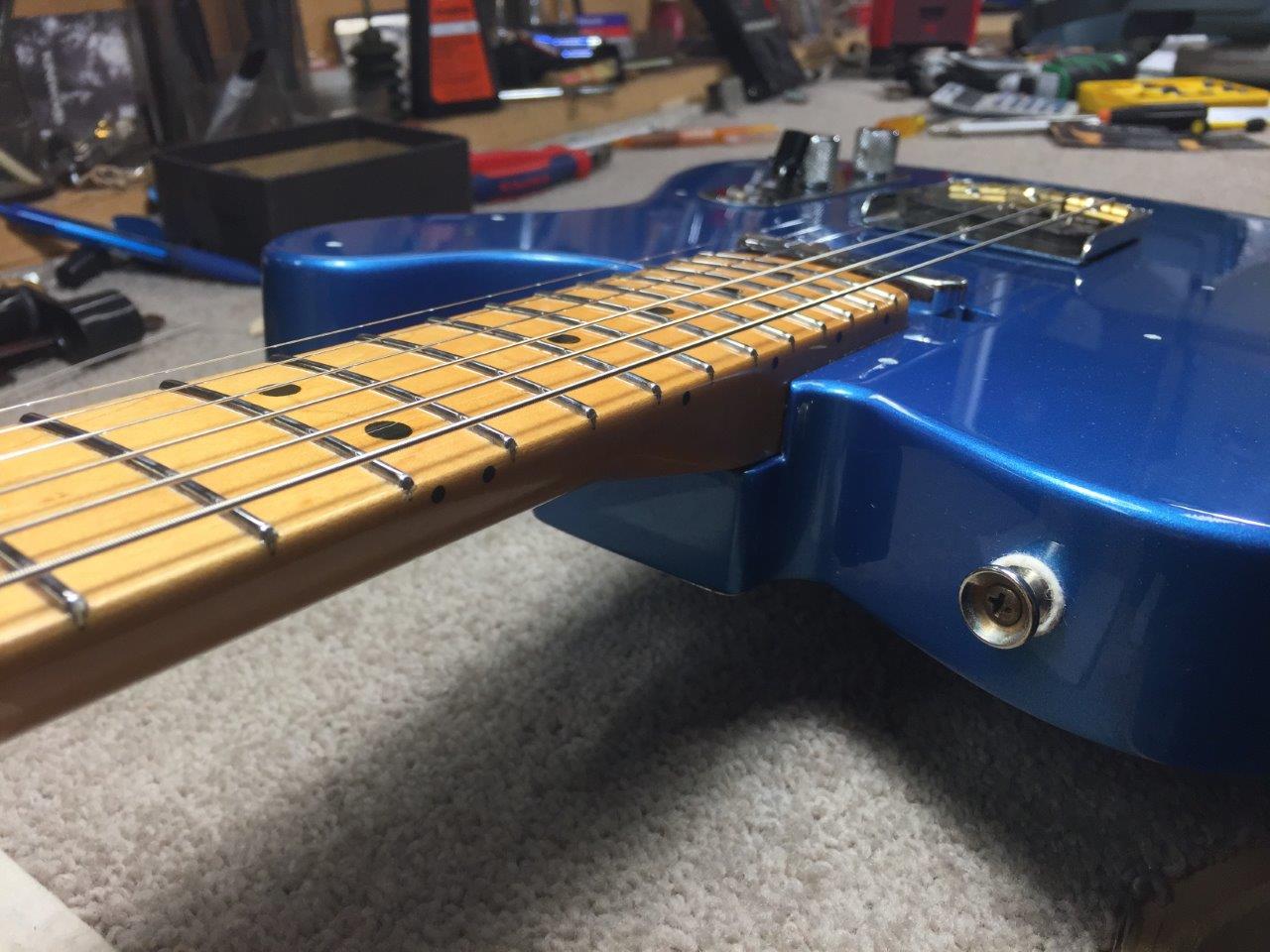
Ok having completed all the assembly work we are skipping now to the final stages of the set up.
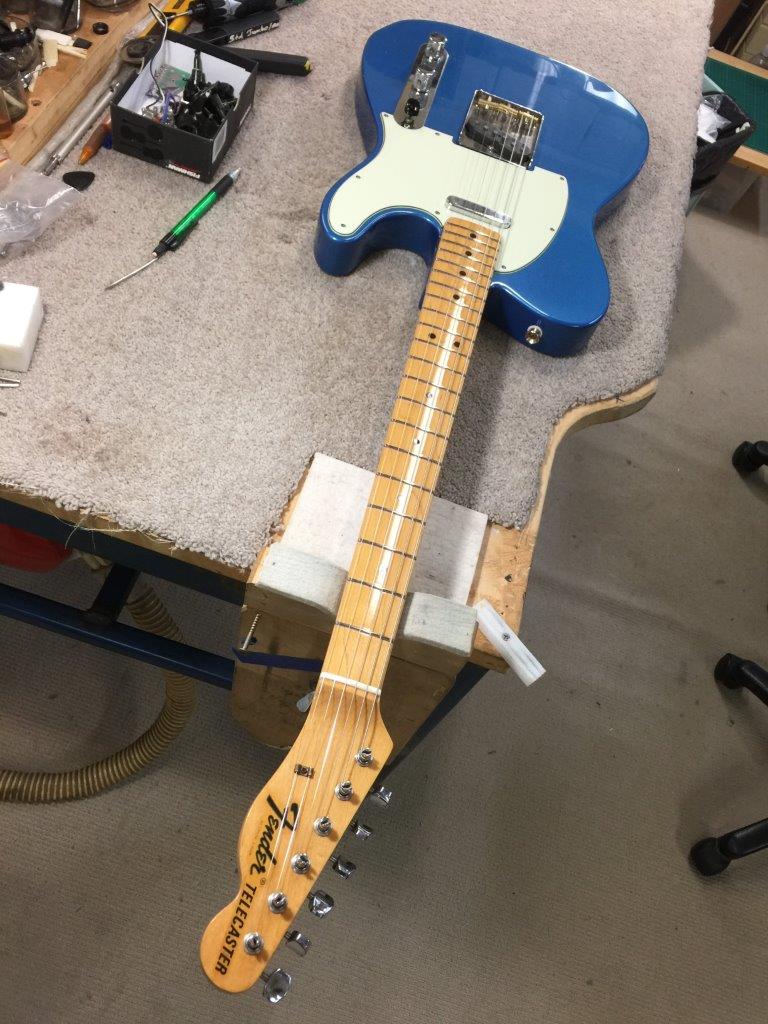
…..And finished!
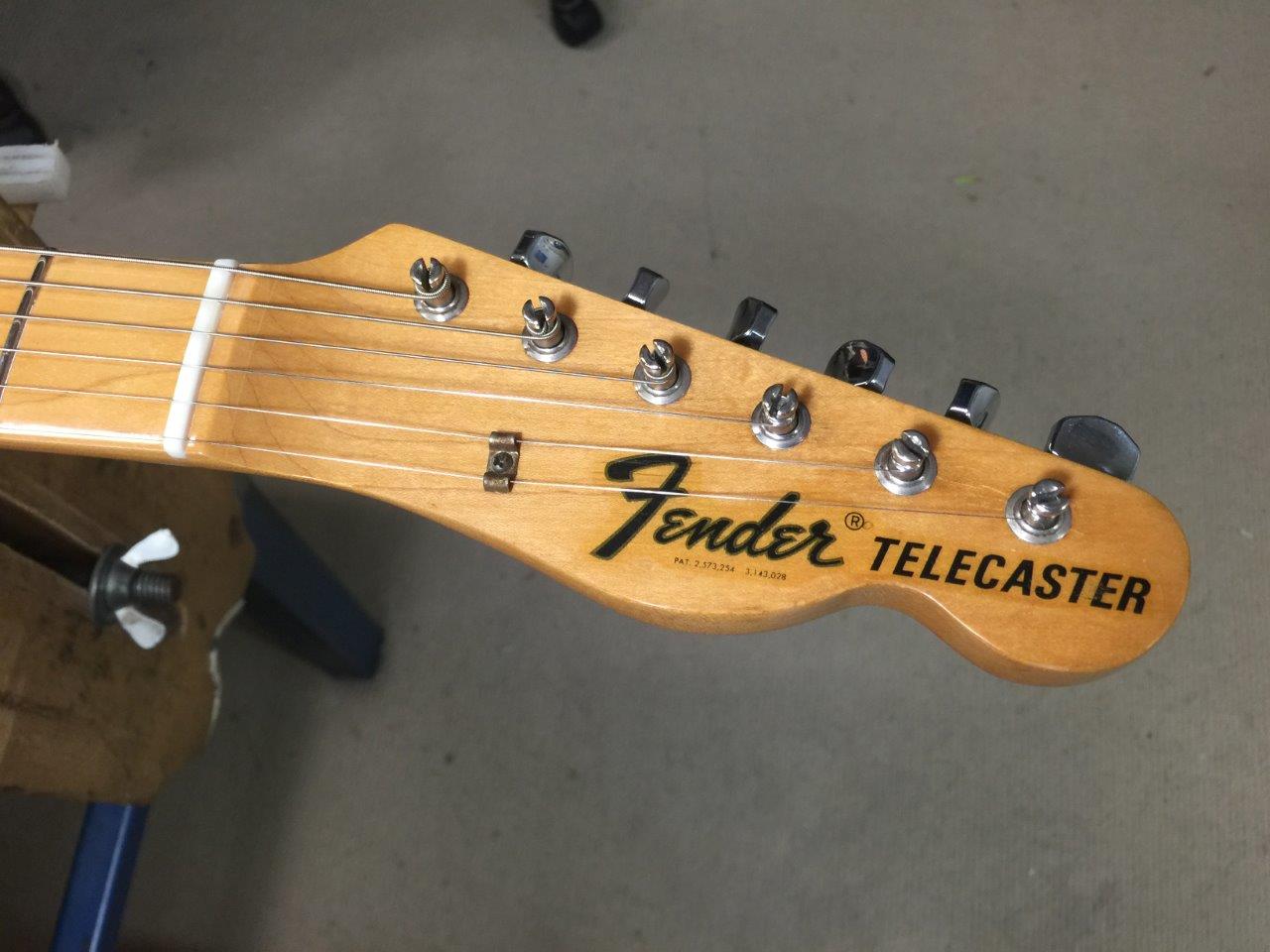
Neck tint chosen to match up with the overall “found under a bed and never played look”.
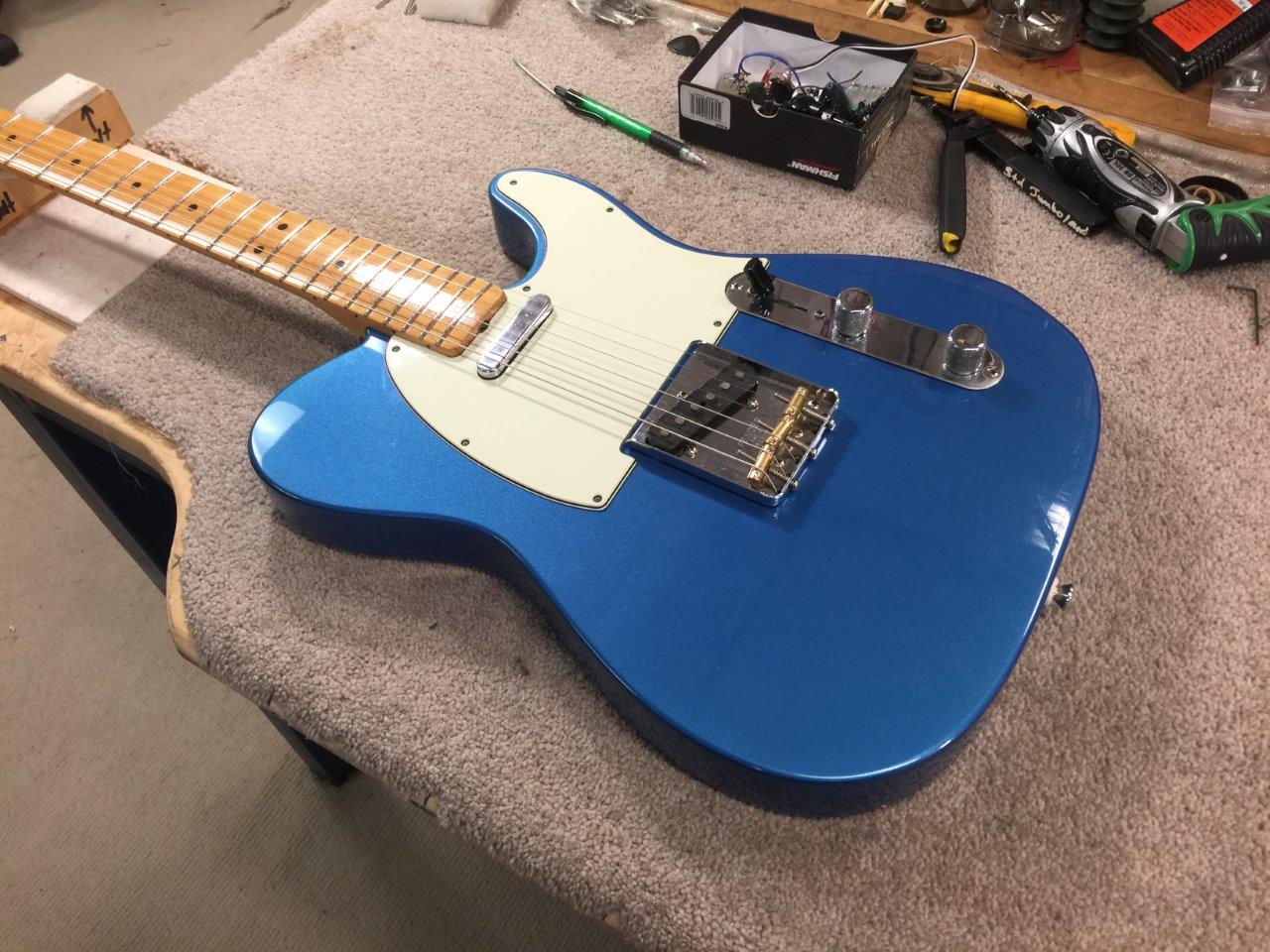
A fully restored 1968 Blue flowers tele now converted over to “LPB” as per the original colour Fender used to seal up the edges from the wallpaper print. All the remains of the wallpaper print were bagged up & retained for proof of origin.

1968 Blue Flowers Tele Restoration.
A 1968 Blue Flowers telecaster as I received it with the specific instructions to “make it like a new guitar”!

As is often the case with the Blue Flowers and Paisley Tele’s of 68 & 69 the wallpaper print has lifted and cracked to the point of being unsalvageable.
Along with the fact that the job arrived with the top already stripped the only thing to do was continue with the process of removing the lifting paper and poly finish from the back.

As can be seen under the neck plate area the colour is unfaded “Lake Placid blue”. This was likewise burst around the edges.

The plan was to refinish the body in its original colour to retain its sense of “provenance”. Likewise to retain all the segments of the wallpaper after it was removed.

What can’t be fully appreciated by the next 2 shots is the enormous amount of work to repair the myriad of dents, marks, gouges, scrapes etc, etc. Remembering that the owner’s specific instruction was “Like new”!

(see prior description)

Just to point out the obvious!

…And again…

It’s interesting what happens to Red alder when its coated with what was in all likelihood an acid cure polyester. The green was perhaps original and the reason why it did not make the grade for a sunburst, but the rest has quite a “bleached look” about it. Having already done a second 68 Tele earlier for the same owner the colour of the wood was the same. Not at all like the usual colour of Red alder but rather a washed out bleached colour. Both were originally acid cure Polyester.

(See prior)

More dents, more dents, more dents & the silver base coat for the LPB burst edges.

(see prior)

Ready now for the time consuming part called dent repair…..

Here we have the neck already re-fretted, fully stripped & ready to be refinished

Having completed all the paintwork we are now on the home stretch. A new “lightly aged” Lake Placid Blue finish with the original brand (Lucite) that Fender used back in the day.

(see prior)

Ok having completed all the assembly work we are skipping now to the final stages of the set up.

…..And finished!

Neck tint chosen to match up with the overall “found under a bed and never played look”.

A fully restored 1968 Blue flowers tele now converted over to “LPB” as per the original colour Fender used to seal up the edges from the wallpaper print. All the remains of the wallpaper print were bagged up & retained for proof of origin.

F-Style Mandolin
One of John Liddy’s beautifully-made F style mandolins in for a refret.

Fret work & set up all completed.

The result was a very happy owner of a seriously good mandolin.

F-Style Mandolin
One of John Liddy’s beautifully made F style mandolins in for a refret.

Fret work & set up all completed.

The result was a very happy owner of a seriously good mandolin.

Fender 1963 Stratocaster Restoration
It’s not often you see a genuine 63 with a fake decal! The Head-stock has been refinished and there is a bit of a mess around the tuner bushes…
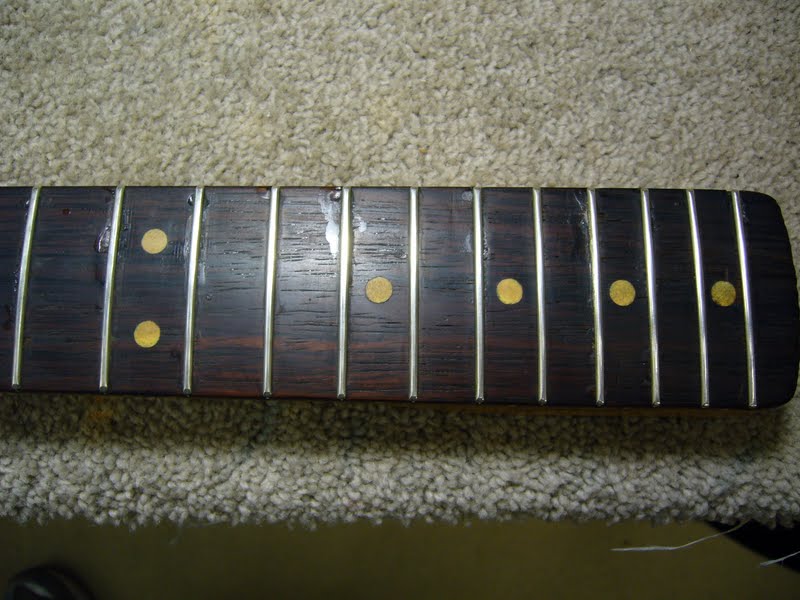
This is how the neck looked when it came in for repair….superglue and chip-outs absolutely everywhere. Thankfully the clay dots were still all intact and the original dimensions of the neck were untampered with.
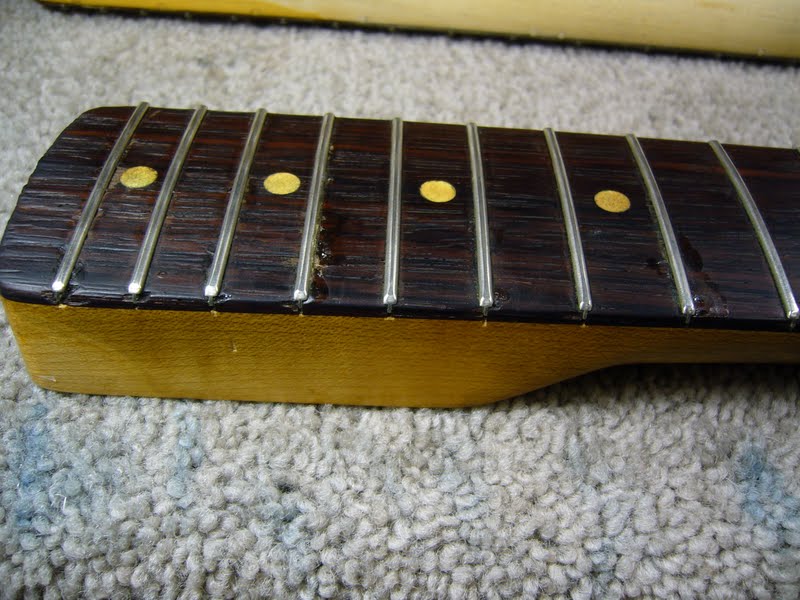
Ah well, its nothing that can’t be repaired.

This is all that remains of the original finish. The neck has gone green from years of playing but with some careful cleaning it came up amazingly well.

…

With a lot of careful detail work and ‘no filler’…, the head-stock face has been restored to about 90 %.
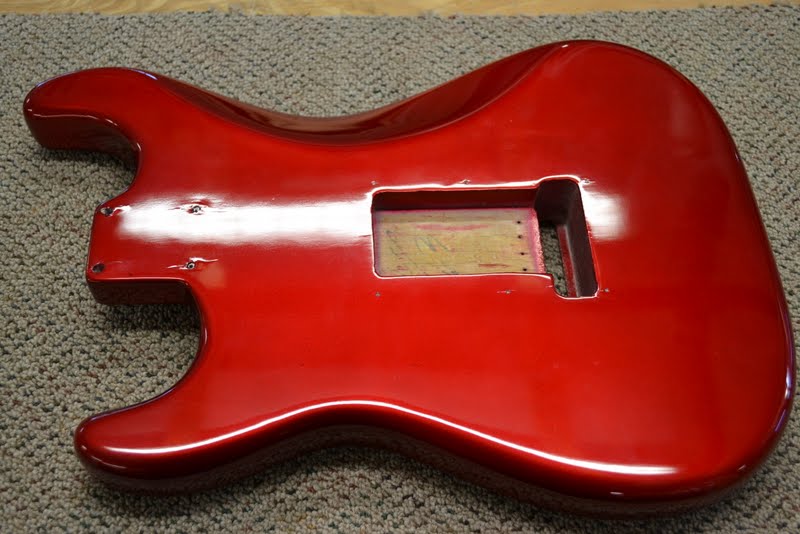
The body had originally been Candy apple red but sometime during its past life had been refinished twice. Once in black and later again in Candy. This is how I received it.
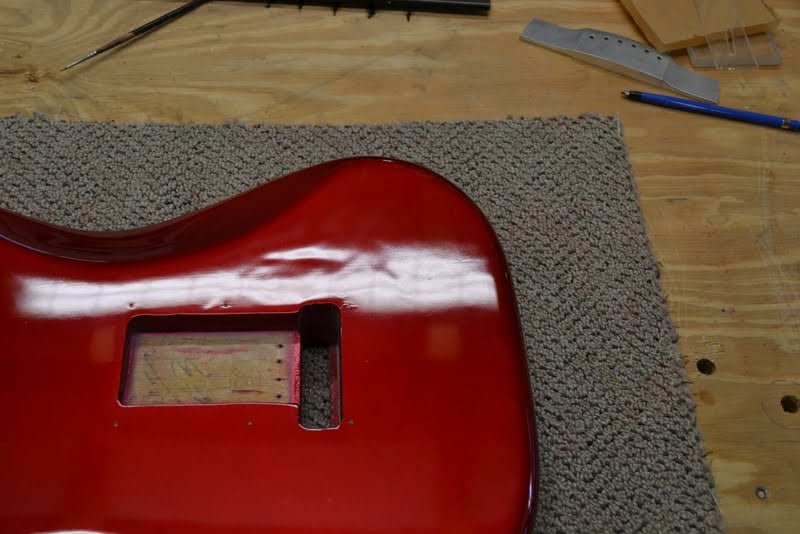
Apart from the rather lumpy refin, thats a real 2/63 date still underneath the original ‘Fullerplast’ sealer.
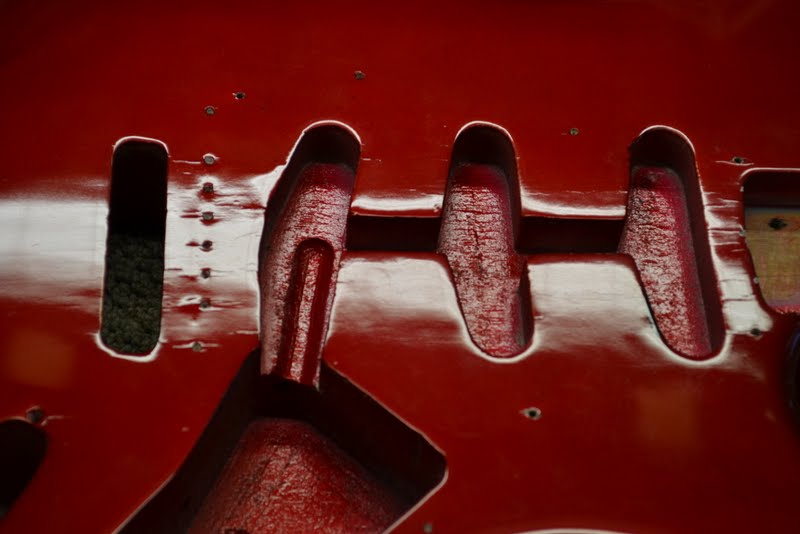
Its all going to have to come off!
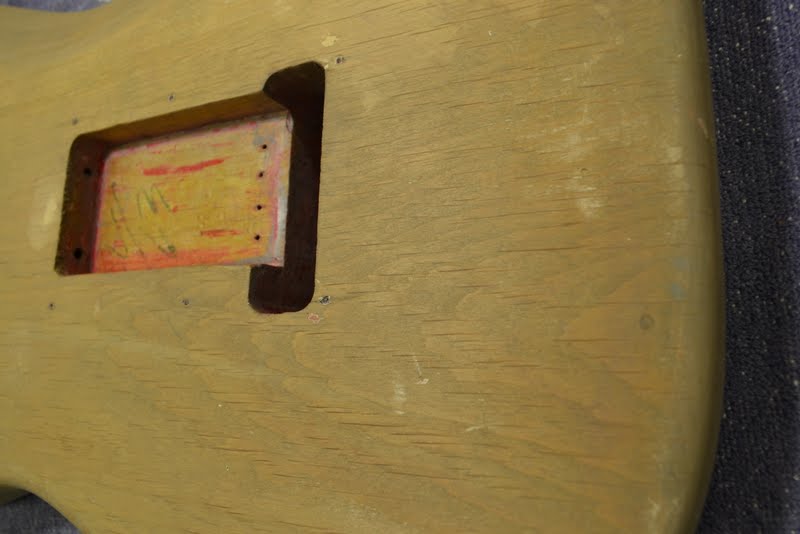
That magic date underneath the sealer and the yellow stain that fender began using around this period.
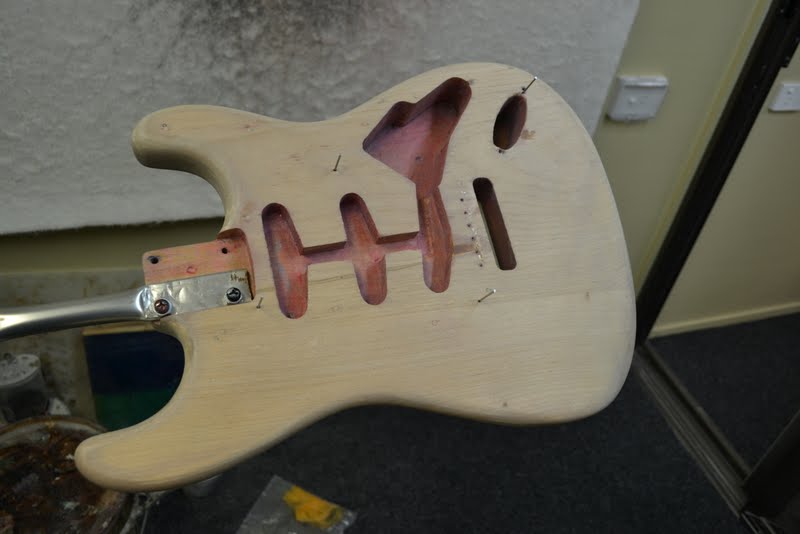

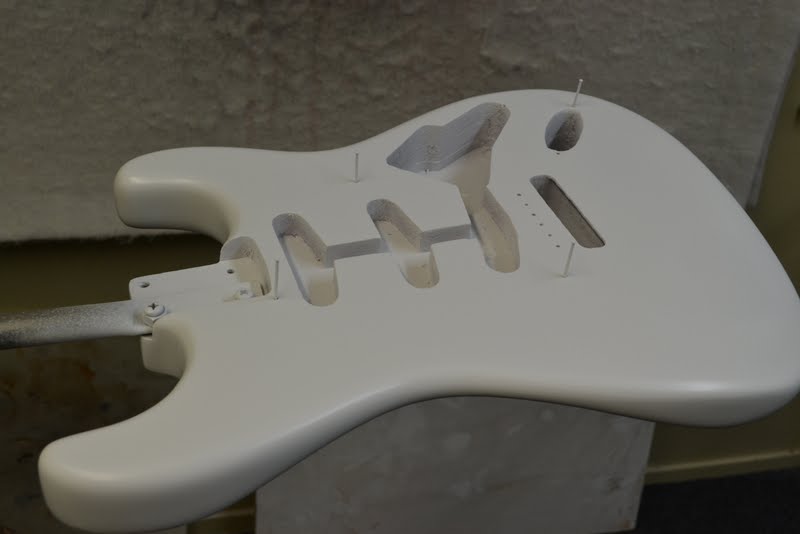
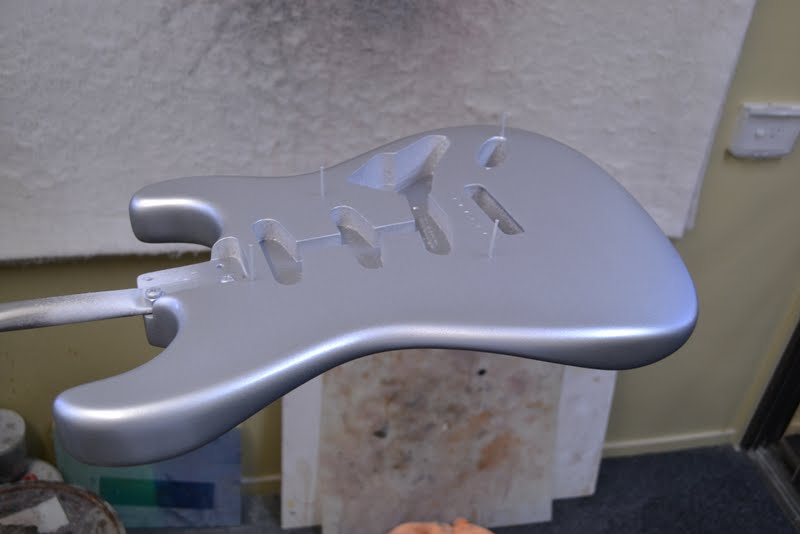

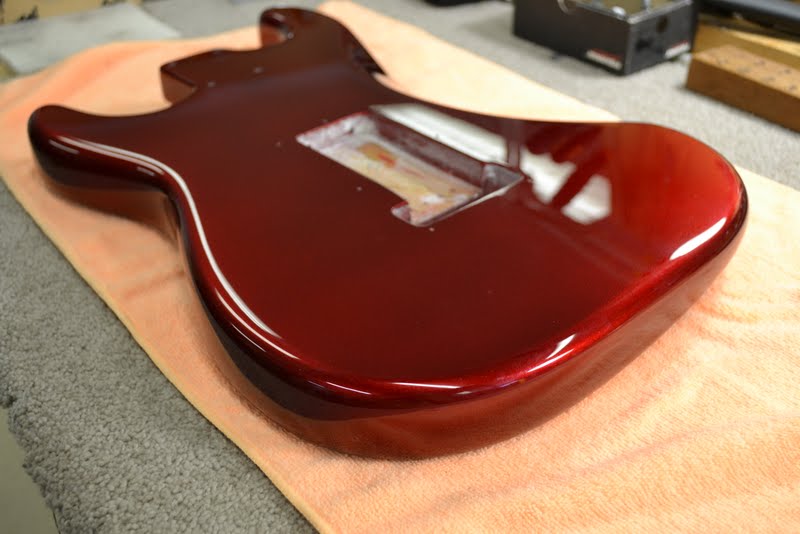
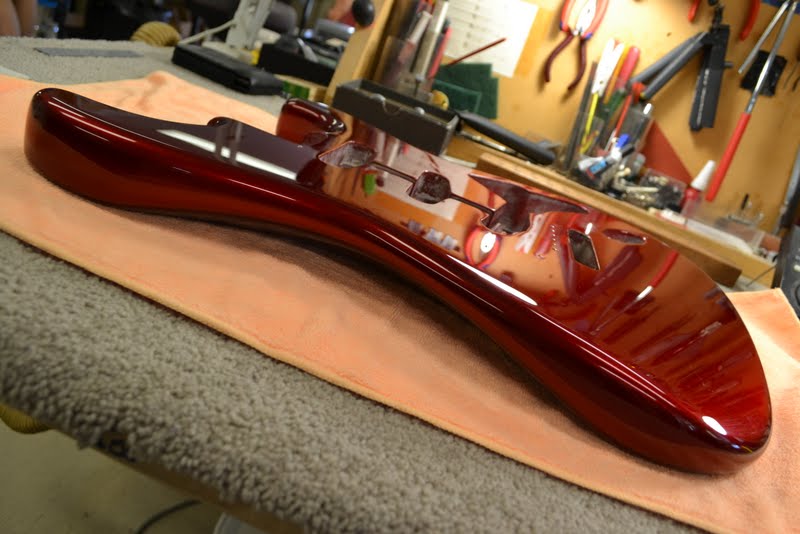
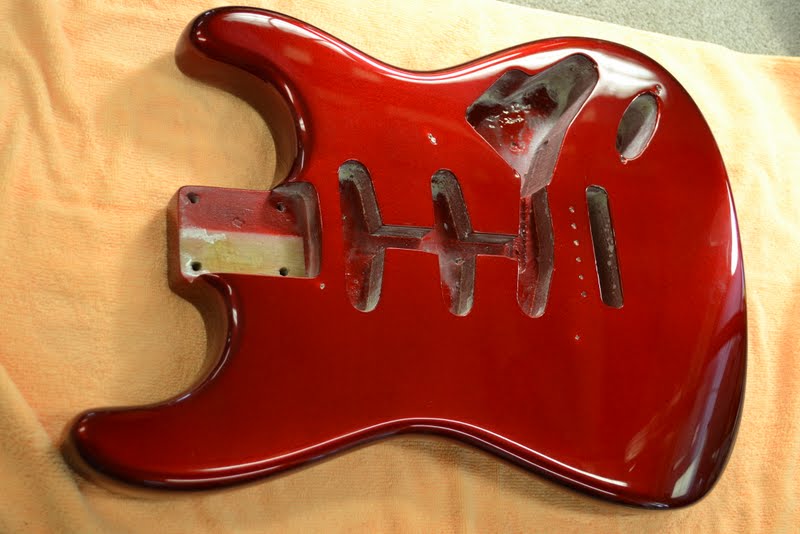
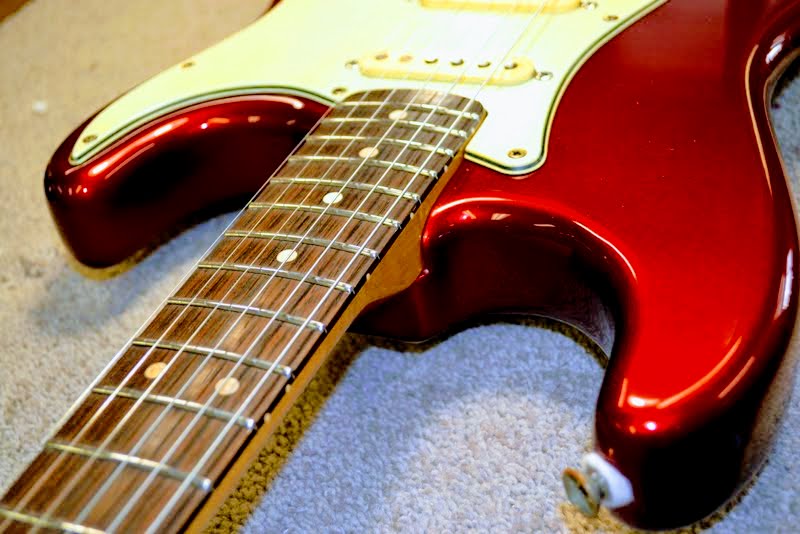

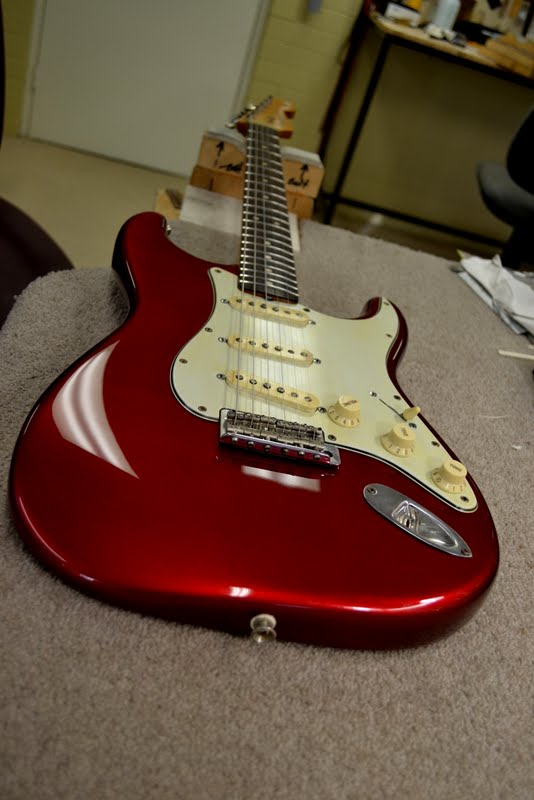
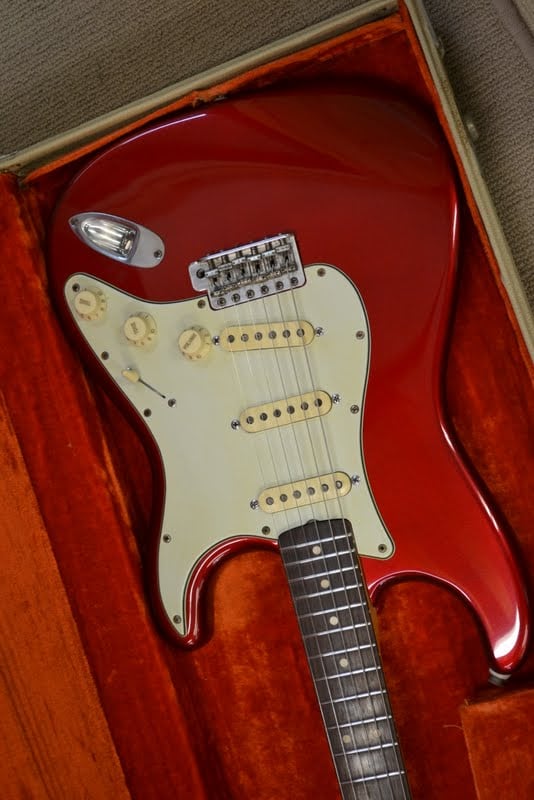

Fender 1963 Stratocaster Restoration
It’s not often you see a genuine 63 with a fake decal! The Head-stock has been refinished and there is a bit of a mess around the tuner bushes…

This is how the neck looked when it came in for repair….superglue and chip-outs absolutely everywhere. Thankfully the clay dots were still all intact and the original dimensions of the neck were untampered with.

Ah well, its nothing that can’t be repaired.

This is all that remains of the original finish. The neck has gone green from years of playing but with some careful cleaning it came up amazingly well.

…

With a lot of careful detail work and ‘no filler’…, the head-stock face has been restored to about 90 %.

The body had originally been Candy apple red but sometime during its past life had been refinished twice. Once in black and later again in Candy. This is how I received it.

Apart from the rather lumpy refin, thats a real 2/63 date still underneath the original ‘Fullerplast’ sealer.

Its all going to have to come off!

That magic date underneath the sealer and the yellow stain that fender began using around this period.













1965 Fender Stratocaster Refret
A previous owner had some “super jumbos” installed. Unfortunately, they were not very well installed and unable to be retained.
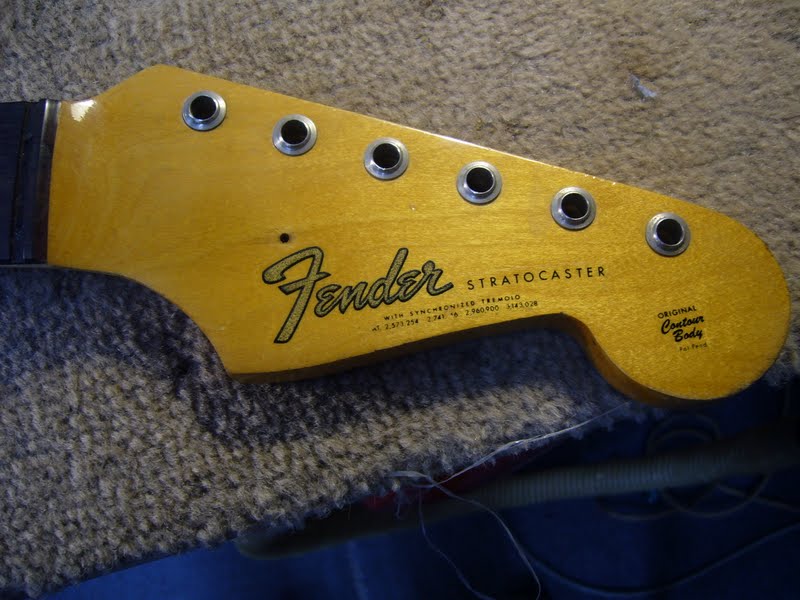
A ’65 strat in for a much-needed refret.
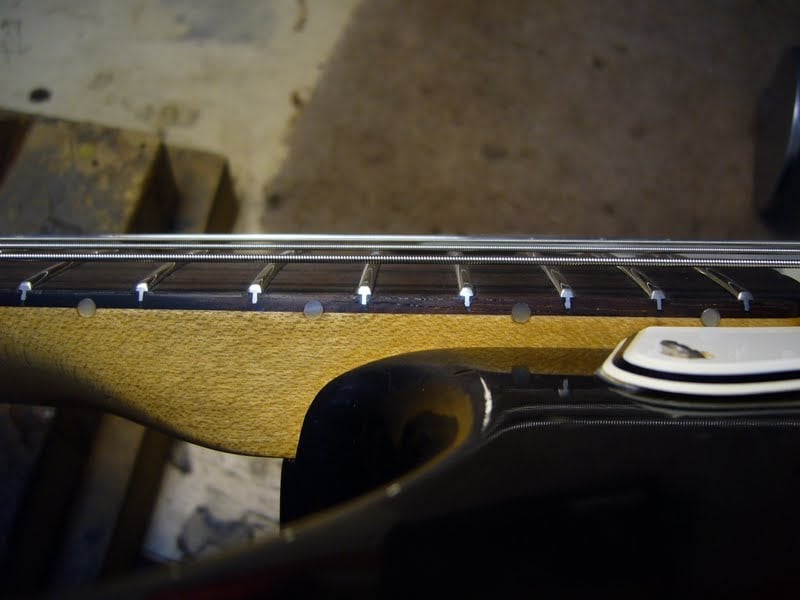
Now refretted with standard mediums as the owner had felt that it needed to go back to an original feel

With new precision fretwork and set up completed, the fullness of tone and play ability of this classic guitar is restored

1. Les Paul Neck Repair

2

3.

4.

5.

6.
On to the neck refinishing.

7.

8

9.
Came up quite nicely

10

11

Les Paul Neck Repair

2

3.

4.

5.

6.
On to the neck refinishing.

7.

8

9.
Came up quite nicely

10

11

1965 Fender Stratocaster Refret
A previous owner had some “super jumbos” installed. Unfortunately, they were not very well installed and unable to be retained.

A ’65 strat in for a much-needed refret.

Now refretted with standard mediums as the owner had felt that it needed to go back to an original feel

With new precision fretwork and set up completed, the fullness of tone and play ability of this classic guitar is restored

Spector 6 string Bass
A very nice Spector 6 string Bass in for a refret.

…..And now completed!

Spector 6 string Bass
A very nice Spector 6 string Bass in for a refret.

…..And now completed!
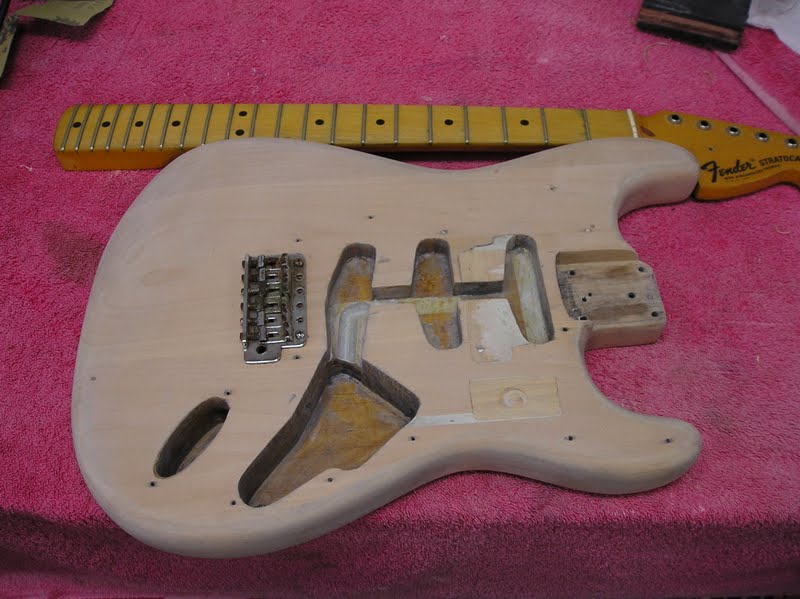
71 Fender '4 bolt' Stratocaster
From this: a 71 ‘4 bolt’ Strat supplied to me in this condition….

To This!
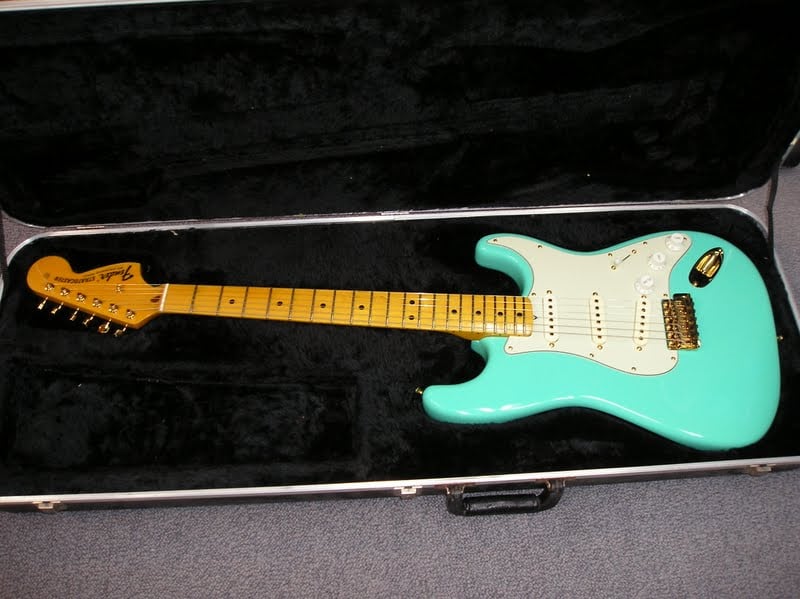
Both the neck and the body needed an awful lot of repair. But refretted, refinished along with a proper setup and some Kinman pickups, this guitar really sang. In spite of how it arrived in my workshop, it remains one of the best sounding early 70’s strats I’ve ever played. You just never can tell…

71 Fender '4 bolt' Stratocaster
From this; a 71 ‘4 bolt’ Strat supplied to me in this condition….

To This!

Both the neck and the body needed an awful lot of repair. But refretted, refinished along with a proper setup and some Kinman pickups, this guitar really sang. In spite of how it arrived in my workshop, it remains one of the best sounding early 70’s strats I’ve ever played. You just never can tell…
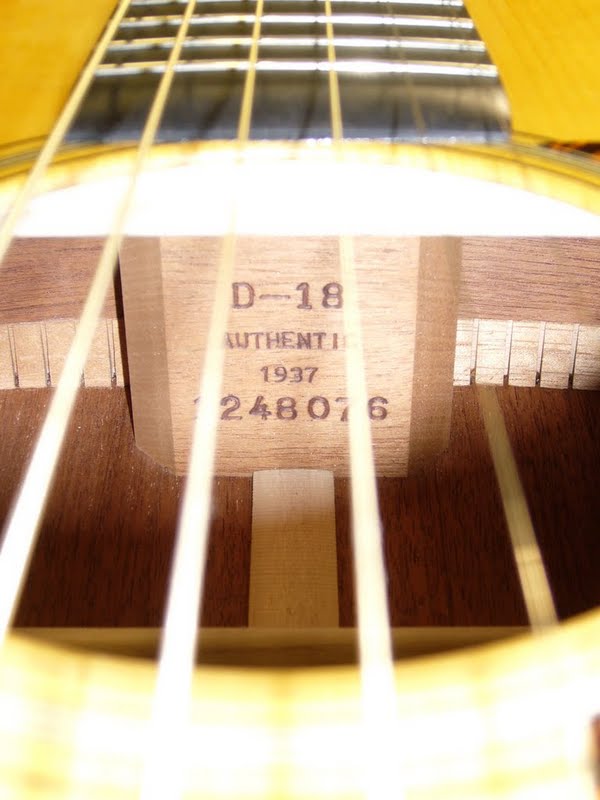
Martin D18 Authentic Refret
A lovely Martin D18 Authentic in with some serious playability issues
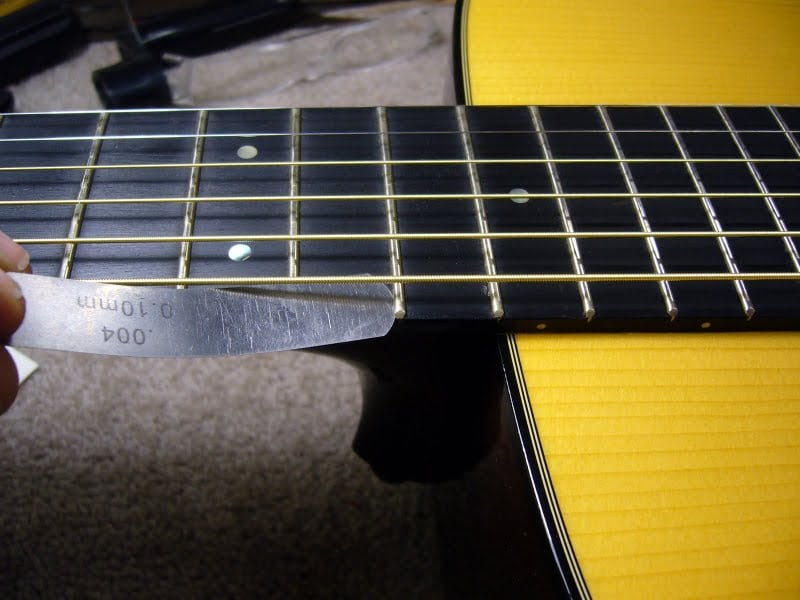
Thankfully it doesn’t need a neck reset but it does have some serious geometry issues which can only be properly attended to with a re-fret. As it happens, the frets are also lifting all the way down the neck any way…..
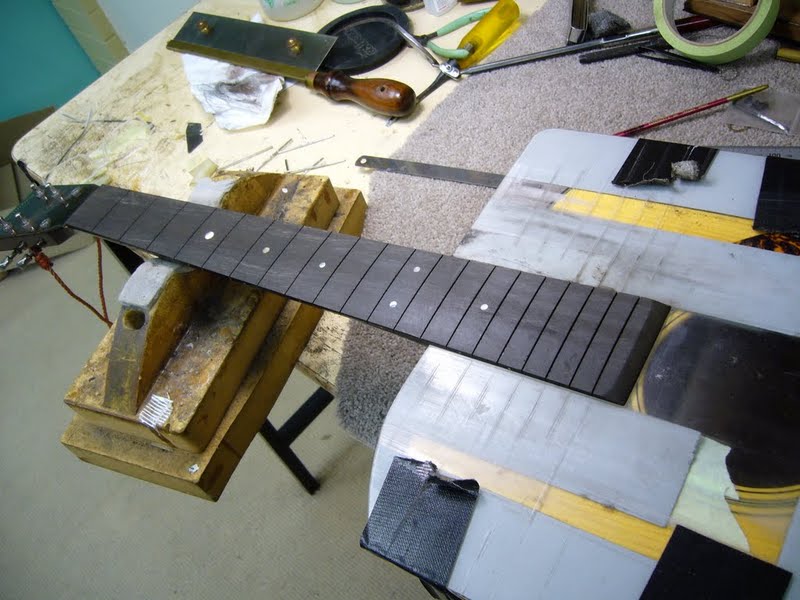
Re-surfacing and re-radiusing the fretboard to ensure a truely accurate surface.

With the refret completed the guitar is now properly set up

A great sounding and effortlessly playing Martin

Martin D18 Authentic Refret
A lovely Martin D18 Authentic in with some serious playability issues

Thankfully it doesn’t need a neck reset but it does have some serious geometry issues which can only be properly attended to with a re-fret. As it happens, the frets are also lifting all the way down the neck any way…..

Re-surfacing and re-radiusing the fretboard to ensure a truely accurate surface.

With the refret completed the guitar is now properly set up

A great sounding and effortlessly playing Martin
